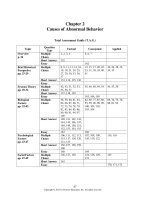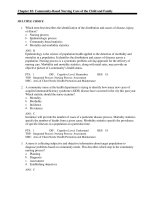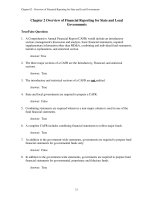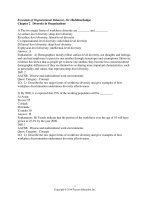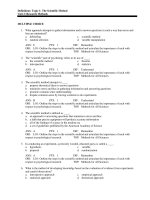Essentials of understanding psychology 11th edition feldman test bank
Bạn đang xem bản rút gọn của tài liệu. Xem và tải ngay bản đầy đủ của tài liệu tại đây (408.86 KB, 132 trang )
Chapter 02 - Neuroscience and Behavior
Chapter 02
Neuroscience and Behavior
Multiple Choice Questions
1.
Psychologists who specialize in considering the ways in which the biological structures and functions of the body affect
behavior are known as _____.
A.
genetic psychologists
B.
biopsychologists
C.
evolutionary psychologists
D.
clinical neuropsychologists
APA LO: 1.1
Accessibility: Keyboard Navigation
Bloom's Taxonomy: Remember
Difficulty: Easy
Learning Objective: Identify the parts of a neuron, and explain how they transmit information.
Learning Outcome: 5-1
Topic: Neurons
2-1
Copyright © 2015 McGraw-Hill Education. All rights reserved. No reproduction or distribution without the prior written consent of
McGraw-Hill Education.
Chapter 02 - Neuroscience and Behavior
2.
Alison has developed an interest in the ways in which the biological structures and functions of the body affect behavior. She
will most likely become a(n):
A.
genetic psychologist.
B.
behavioral neuroscientist.
C.
evolutionary psychologist.
D.
clinical neuropsychologist.
APA LO: 1.2
APA LO: 1.3
Accessibility: Keyboard Navigation
Bloom's Taxonomy: Apply
Difficulty: Medium
Learning Objective: Identify the parts of a neuron, and explain how they transmit information.
Learning Outcome: 5-1
Topic: Neurons
2-2
Copyright © 2015 McGraw-Hill Education. All rights reserved. No reproduction or distribution without the prior written consent of
McGraw-Hill Education.
Chapter 02 - Neuroscience and Behavior
3.
The basic elements of the nervous system are called:
A.
axons.
B.
glial cells.
C.
neurons.
D.
neurotransmitters.
APA LO: 1.1
Accessibility: Keyboard Navigation
Bloom's Taxonomy: Remember
Difficulty: Easy
Learning Objective: Identify the parts of a neuron, and explain how they transmit information.
Learning Outcome: 5-2
Topic: Neurons
2-3
Copyright © 2015 McGraw-Hill Education. All rights reserved. No reproduction or distribution without the prior written consent of
McGraw-Hill Education.
Chapter 02 - Neuroscience and Behavior
4.
As many as _____ neurons throughout the body are involved in the control of behavior.
A.
1 billion
B.
1 trillion
C.
5 million
D.
50 million
APA LO: 1.2
Accessibility: Keyboard Navigation
Bloom's Taxonomy: Remember
Difficulty: Easy
Learning Objective: Describe how nerve cells communicate with other nerve cells.
Learning Outcome: 5-2
Topic: Neurons
2-4
Copyright © 2015 McGraw-Hill Education. All rights reserved. No reproduction or distribution without the prior written consent of
McGraw-Hill Education.
Chapter 02 - Neuroscience and Behavior
5.
Neurons are physically held in place by _____.
A.
axons
B.
glial cells
C.
dendrites
D.
myelin cells
APA LO: 1.2
Accessibility: Keyboard Navigation
Bloom's Taxonomy: Remember
Difficulty: Easy
Learning Objective: Identify the parts of a neuron, and explain how they transmit information.
Learning Outcome: 5-2
Topic: Neurons
2-5
Copyright © 2015 McGraw-Hill Education. All rights reserved. No reproduction or distribution without the prior written consent of
McGraw-Hill Education.
Chapter 02 - Neuroscience and Behavior
6.
Which of the following is NOT one of the functions of glial cells?
A.
They nourish nerve cells.
B.
They communicate messages within the nervous system.
C.
They help repair damage that might occur to neurons.
D.
They provide nourishment to neurons.
APA LO: 1.2
Accessibility: Keyboard Navigation
Bloom's Taxonomy: Understand
Difficulty: Medium
Learning Objective: Name the key neurotransmitters and their functions and describe their known or suspected roles in behavior as well as
in illnesses.
Learning Outcome: 5-2
Topic: How Neurons Fire
2-6
Copyright © 2015 McGraw-Hill Education. All rights reserved. No reproduction or distribution without the prior written consent of
McGraw-Hill Education.
Chapter 02 - Neuroscience and Behavior
7.
A cluster of fibers at one end of a neuron that receives messages from other neurons is called:
A.
axon.
B.
terminal button.
C.
glial fiber.
D.
dendrite.
APA LO: 1.2
Accessibility: Keyboard Navigation
Bloom's Taxonomy: Remember
Difficulty: Easy
Learning Objective: Name the key neurotransmitters and their functions and describe their known or suspected roles in behavior as well as
in illnesses.
Learning Outcome: 5-2
Topic: Nervous System
2-7
Copyright © 2015 McGraw-Hill Education. All rights reserved. No reproduction or distribution without the prior written consent of
McGraw-Hill Education.
Chapter 02 - Neuroscience and Behavior
8.
Compare your forearm, palm, wrist, and fingers to a neuron. In such an analogy, the dendrites would be your:
A.
forearm.
B.
fingers.
C.
wrist.
D.
palm.
APA LO: 1.2
Accessibility: Keyboard Navigation
Bloom's Taxonomy: Apply
Difficulty: Medium
Learning Objective: Name the key neurotransmitters and their functions and describe their known or suspected roles in behavior as well as
in illnesses.
Learning Outcome: 5-2
Topic: Nervous System
2-8
Copyright © 2015 McGraw-Hill Education. All rights reserved. No reproduction or distribution without the prior written consent of
McGraw-Hill Education.
Chapter 02 - Neuroscience and Behavior
9.
An axon is a:
A.
neuron's cell body.
B.
cluster of fibers at one end of a neuron.
C.
support cell in the nervous system.
D.
long, slim, tube-like structure extending from a neuron.
APA LO: 1.2
Accessibility: Keyboard Navigation
Bloom's Taxonomy: Remember
Difficulty: Easy
Learning Objective: Name the key neurotransmitters and their functions and describe their known or suspected roles in behavior as well as
in illnesses.
Learning Outcome: 5-2
Topic: Nervous System
2-9
Copyright © 2015 McGraw-Hill Education. All rights reserved. No reproduction or distribution without the prior written consent of
McGraw-Hill Education.
Chapter 02 - Neuroscience and Behavior
10.
Which of the following structures is especially important for carrying messages received by the dendrites to other neurons?
A.
Neurotransmitter
B.
Synapse
C.
Axon
D.
Glial cell
APA LO: 1.2
Accessibility: Keyboard Navigation
Bloom's Taxonomy: Remember
Difficulty: Medium
Learning Objective: Name the key neurotransmitters and their functions and describe their known or suspected roles in behavior as well as
in illnesses.
Learning Outcome: 5-2
Topic: Nervous System
2-10
Copyright © 2015 McGraw-Hill Education. All rights reserved. No reproduction or distribution without the prior written consent of
McGraw-Hill Education.
Chapter 02 - Neuroscience and Behavior
11.
Terminal buttons are found at the end of:
A.
neurotransmitters.
B.
dendrites.
C.
axons.
D.
glial cells.
APA LO: 1.2
Accessibility: Keyboard Navigation
Bloom's Taxonomy: Remember
Difficulty: Easy
Learning Objective: Name the key neurotransmitters and their functions and describe their known or suspected roles in behavior as well as
in illnesses.
Learning Outcome: 5-2
Topic: Nervous System
2-11
Copyright © 2015 McGraw-Hill Education. All rights reserved. No reproduction or distribution without the prior written consent of
McGraw-Hill Education.
Chapter 02 - Neuroscience and Behavior
12.
Which of the following sequences correctly arranges nervous system structures from the most general to the most specific?
A.
Neuron – axon – terminal button
B.
Neuron – terminal button – axon
C.
Axon – terminal button – neuron
D.
Axon – neuron – terminal button
APA LO: 1.2
Accessibility: Keyboard Navigation
Bloom's Taxonomy: Understand
Difficulty: Medium
Learning Objective: Identify the parts of a neuron, and explain how they transmit information.
Learning Outcome: 5-2
Topic: Nervous System
2-12
Copyright © 2015 McGraw-Hill Education. All rights reserved. No reproduction or distribution without the prior written consent of
McGraw-Hill Education.
Chapter 02 - Neuroscience and Behavior
13.
Dendrite is to axon what _____ is to _____.
A.
receiving; sending
B.
sending; receiving
C.
reuptake; action potential
D.
action potential; reuptake
APA LO: 1.2
Accessibility: Keyboard Navigation
Bloom's Taxonomy: Understand
Difficulty: Easy
Learning Objective: Identify the parts of a neuron, and explain how they transmit information.
Learning Outcome: 5-2
Topic: How Neurons Fire
2-13
Copyright © 2015 McGraw-Hill Education. All rights reserved. No reproduction or distribution without the prior written consent of
McGraw-Hill Education.
Chapter 02 - Neuroscience and Behavior
14.
Compare your forearm, palm, knuckles, and fingers to a neuron. In such an analogy, the axon would be your:
A.
forearm.
B.
fingers.
C.
palm.
D.
knuckles.
APA LO: 1.2
Accessibility: Keyboard Navigation
Bloom's Taxonomy: Apply
Difficulty: Easy
Learning Objective: Identify the parts of a neuron, and explain how they transmit information.
Learning Outcome: 5-2
Topic: How Neurons Fire
2-14
Copyright © 2015 McGraw-Hill Education. All rights reserved. No reproduction or distribution without the prior written consent of
McGraw-Hill Education.
Chapter 02 - Neuroscience and Behavior
15.
Which of the following sequences accurately reflects the route followed by nerve impulses when one neuron communicates
with another?
A.
Dendrite – axon – cell body
B.
Dendrite – cell body – axon
C.
Cell body – axon – dendrite
D.
Axon – dendrite – cell body
APA LO: 1.2
Accessibility: Keyboard Navigation
Bloom's Taxonomy: Understand
Difficulty: Medium
Learning Objective: Identify the parts of a neuron, and explain how they transmit information.
Learning Outcome: 5-2
Topic: Neurotransmitters
2-15
Copyright © 2015 McGraw-Hill Education. All rights reserved. No reproduction or distribution without the prior written consent of
McGraw-Hill Education.
Chapter 02 - Neuroscience and Behavior
16.
Electrical wires are generally protected by a tube of plastic. A similar insulating function is performed in the nervous system
by the:
A.
myelin sheath.
B.
glial cells.
C.
terminal buttons.
D.
synapse.
APA LO: 1.2
Accessibility: Keyboard Navigation
Bloom's Taxonomy: Understand
Difficulty: Medium
Learning Objective: Identify the parts of a neuron, and explain how they transmit information.
Learning Outcome: 5-2
Topic: Neurotransmitters
2-16
Copyright © 2015 McGraw-Hill Education. All rights reserved. No reproduction or distribution without the prior written consent of
McGraw-Hill Education.
Chapter 02 - Neuroscience and Behavior
17.
_____ is a protective coat of fat and protein that wraps around the axon.
A.
Myelin sheath
B.
Glial cell
C.
Dendrite
D.
Synapse
APA LO: 1.2
Accessibility: Keyboard Navigation
Bloom's Taxonomy: Remember
Difficulty: Easy
Learning Objective: Identify the parts of a neuron, and explain how they transmit information.
Learning Outcome: 5-2
Topic: Neurotransmitters
2-17
Copyright © 2015 McGraw-Hill Education. All rights reserved. No reproduction or distribution without the prior written consent of
McGraw-Hill Education.
Chapter 02 - Neuroscience and Behavior
18.
You cannot fire a gun softly, or flush a toilet halfway. Like an action potential, gun fire and a toilet's flush follow the _____
law.
A.
incremental transformation
B.
graded action
C.
all-or-none
D.
intensity of stimulus
APA LO: 1.2
Accessibility: Keyboard Navigation
Bloom's Taxonomy: Understand
Difficulty: Medium
Learning Objective: Identify the parts of a neuron, and explain how they transmit information.
Learning Outcome: 5-2
Topic: How Neurons Fire
2-18
Copyright © 2015 McGraw-Hill Education. All rights reserved. No reproduction or distribution without the prior written consent of
McGraw-Hill Education.
Chapter 02 - Neuroscience and Behavior
19.
The rule that neurons are either on or off is known as the _____ law.
A.
intensity of stimulus
B.
graded action
C.
all-or-none
D.
incremental transformational
APA LO: 1.2
Accessibility: Keyboard Navigation
Bloom's Taxonomy: Remember
Difficulty: Easy
Learning Objective: Describe how nerve cells communicate with other nerve cells.
Learning Outcome: 5-2
Topic: How Neurons Fire
2-19
Copyright © 2015 McGraw-Hill Education. All rights reserved. No reproduction or distribution without the prior written consent of
McGraw-Hill Education.
Chapter 02 - Neuroscience and Behavior
20.
The state in which there is a negative electrical charge of about -70 millivolts within a neuron is known as the _____ state.
A.
triggering
B.
terminal
C.
optimum
D.
resting
APA LO: 1.2
Accessibility: Keyboard Navigation
Bloom's Taxonomy: Remember
Difficulty: Easy
Learning Objective: Describe how nerve cells communicate with other nerve cells.
Learning Outcome: 5-2
Topic: Speed of Transmission
2-20
Copyright © 2015 McGraw-Hill Education. All rights reserved. No reproduction or distribution without the prior written consent of
McGraw-Hill Education.
Chapter 02 - Neuroscience and Behavior
21.
Regarding action potentials, which of the following statements is TRUE?
A.
As the impulse travels along the axon, the movement of ions causes a change in charge from positive to neutral in successive
sections of the axon.
B.
The action potential moves from one end of the axon to the other like a flame moving along a fuse.
C.
After the impulse has passed through a particular section of the axon, negative ions are pumped out of that section, and its
charge returns to positive while the action potential continues to move along the axon.
D.
Just after an action potential has passed through a section of the axon, a neuron can fire again immediately if it receives
appropriate stimulation.
APA LO: 1.2
Accessibility: Keyboard Navigation
Bloom's Taxonomy: Remember
Difficulty: Medium
Learning Objective: Name the key neurotransmitters and their functions and describe their known or suspected roles in behavior as well as
in illnesses.
Learning Outcome: 5-2
Topic: Speed of Transmission
2-21
Copyright © 2015 McGraw-Hill Education. All rights reserved. No reproduction or distribution without the prior written consent of
McGraw-Hill Education.
Chapter 02 - Neuroscience and Behavior
22.
As an action potential occurs, the neuron's electrical charge:
A.
changes from negative to neutral.
B.
changes from positive to neutral.
C.
changes from negative to positive.
D.
changes from positive to negative.
APA LO: 1.2
Accessibility: Keyboard Navigation
Bloom's Taxonomy: Remember
Difficulty: Medium
Learning Objective: Name the key neurotransmitters and their functions and describe their known or suspected roles in behavior as well as
in illnesses.
Learning Outcome: 5-2
Topic: Speed of Transmission
2-22
Copyright © 2015 McGraw-Hill Education. All rights reserved. No reproduction or distribution without the prior written consent of
McGraw-Hill Education.
Chapter 02 - Neuroscience and Behavior
23.
_____ are specialized neurons that fire not only when a person enacts a particular behavior, but also when a person simply
observes another individual carrying out the same behavior.
A.
Pharyngeal motor neuron
B.
Mirror neurons
C.
Ventral cord motor neuron
D.
Amphid neurons
APA LO: 1.2
Accessibility: Keyboard Navigation
Bloom's Taxonomy: Remember
Difficulty: Easy
Learning Objective: Name the key neurotransmitters and their functions and describe their known or suspected roles in behavior as well as
in illnesses.
Learning Outcome: 5-2
Topic: Mirror Neurons
2-23
Copyright © 2015 McGraw-Hill Education. All rights reserved. No reproduction or distribution without the prior written consent of
McGraw-Hill Education.
Chapter 02 - Neuroscience and Behavior
24.
Regarding mirror neurons, which of the following statements is ACCURATE?
A.
Mirror neurons are involved in face recognition and language acquisition, but not in empathy.
B.
Mirror neurons are involved in empathy and face recognition, but not in language acquisition.
C.
Mirror neurons are involved in empathy, language acquisition, and face recognition.
D.
Mirror neurons are involved in empathy and language acquisition, but not in face recognition.
APA LO: 1.2
Accessibility: Keyboard Navigation
Bloom's Taxonomy: Understand
Difficulty: Medium
Learning Objective: Name the key neurotransmitters and their functions and describe their known or suspected roles in behavior as well as
in illnesses.
Learning Outcome: 5-2
Topic: Mirror Neurons
2-24
Copyright © 2015 McGraw-Hill Education. All rights reserved. No reproduction or distribution without the prior written consent of
McGraw-Hill Education.
Chapter 02 - Neuroscience and Behavior
25.
A synapse is a:
A.
chemical.
B.
signal.
C.
joint.
D.
gap.
APA LO: 1.2
Accessibility: Keyboard Navigation
Bloom's Taxonomy: Understand
Difficulty: Medium
Learning Objective: Name the key neurotransmitters and their functions and describe their known or suspected roles in behavior as well as
in illnesses.
Learning Outcome: 5-2
Topic: Synapse
2-25
Copyright © 2015 McGraw-Hill Education. All rights reserved. No reproduction or distribution without the prior written consent of
McGraw-Hill Education.

